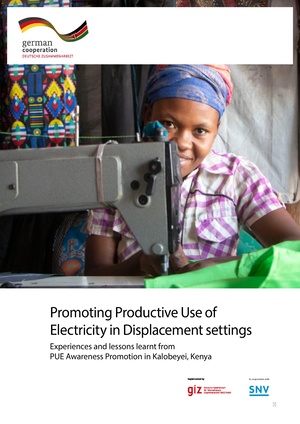Promoting Productive Use of Electricity in Displacement settings
Introduction
GIZ, through the Energy Solutions for Displacement Settings (ESDS) project, seeks to address the lack of a sustainable energy supply in Kalobeyei integrated settlement (KIS) and Kalobeyei Town, Kenya, which hosts 3,500 host community members and 47,700 refugees respectively.
Increased energy access through the mini-grid systems presents the opportunity for the host community and refugee residents, businesses, and institutions in Kalobeyei to expand their electricity usage to livelihood and income generation activities; so-called ‘Productive Use of Electricity’ (PUE). In addition, the uptake of PUE appliances can contribute to the financial sustainability of mini-grids due to increased power consumption. To this end, the ESDS project designed and implemented a campaign aimed at ‘sensitizing households, businesses and social institutions on available opportunities and potential for income generation through PUE in Kalobeyei integrated settlement (KIS) and Kalobeyei town in Kenya.
The promotion of PUE awareness was carried out by SNV on behalf of the ESDS project from July 2022 to December 2022. This report presents the state of PUE in Kalobeyei, the design and campaign activities and, lastly, identifies the recommendations for replication in displacement settings.
Promotion of PUE in Kalobeyei
Summary of PUE promotion activities carried out in Kalobeyei (July to December 2022)
| Project implementation phase | (Primary) target group | Focus PUE appliances |
| 1. Local community sensitisation: on the opportunities and benefits of using electricity for income generating purposes, PUE appliances available in the market and where to buy them.
|
Households and businesses with (expected) electricity access to the Renewvia mini-grids | Mini-grid compatible food preparation appliances (electric cookers, blenders, and toasters), sewing machines, and hair dressing equipment (including hair dryers and shavers). |
| Households and businesses without (expected) access to the existing mini-grids | PUE appliances with stand-alone solar systems including solar-powered fridges, freezers, water pumps, shaving kits, computer, and entertainment services (TVs, radios, and speakers). | |
| PUE appliance suppliers in Kalobeyei and Kakuma town and sub-camps | Mini-grid and stand-alone solar systems compatible PUE appliances | |
| 2. Targeted awareness raising & training for existing and new mini-grid customers: on use of electricity for (additional) income generating purposes.
|
Households and businesses connected to Renewvia mini-grids with basic electricity usage (lighting & charging) | Mini-grid compatible food preparation appliances, fridges, and entertainment systems |
| Households and businesses connected to Renewvia mini-grids with advanced electricity usage (entertainment, cooling, cooking, productive uses) | Mini-grid compatible hairdressing equipment, sewing machines, cooling (fridges and freezers) | |
| Saving groups | Mini-grid compatible appliances | |
| 3.Targeted training for institutions and businesses: on effective utilization, operation & maintenance of PUE appliances
Activities: Trainings |
Institutions: teaching staff of vocational training institutes.
Businesses: (aspiring) tailors and food and beverage services |
Food preparation: EPCs, microwave/ovens, blenders/juicers, air fryers, toasters/sandwich maker, water dispensers and fridges/freezers.
Service category: Electric sewing machines and iron box |
Key findings and lessons learnt
- The use of various channels and local languages is critical.
- There is need for further awareness on available energy sources.
- End user training on proper wiring and safe use of electrical appliances is important.
- PUE appliance vendors are willing to supply specific products on demand.
- Inclusion of VSLAs training as part of PUE promotion is critical.
- Unlock other financing services to support growth in PUE.
- Opportunity to increase PUE uptake through vendor knowledge on O&M.
Recommendations
- Conduct in-depth research prior to the design and implementation of PUE promotion activities to tailor them to the needs of the market segment and supply. The research should include:
- The socio-economic profile of target audiences
- A stakeholder analysis
- A PUE market analysis
- Mini-grid system capacity (constraints) and potential overloading concerns.
- Main communication channels, tools and messages
- Design and implement PUE promotion activities with a clear set of objectives, priority target group(s) and appliances, implementation partners, activities to be accomplished, and tools required using an iterative, ‘phased’ approach.
- Carefully identify, segment, and involve all relevant stakeholders along the value chain
- Choose focus PUE appliances based on:
- Electricity source(s) available to selected target group(s)
- Direct income generation potential (as opposed to complementary services such as fans and radio)
- Market availability and provision of proper after sales service
- Implement trainings on effective utilization, operation and maintenance of electrical appliance(s), and safe and appropriate use of electricity in close consultation with mini-grid operators, appliance vendors and technicians.
The Promoting Productive Use of Electricity in Displacement settings working paper can be downloaded here:




















